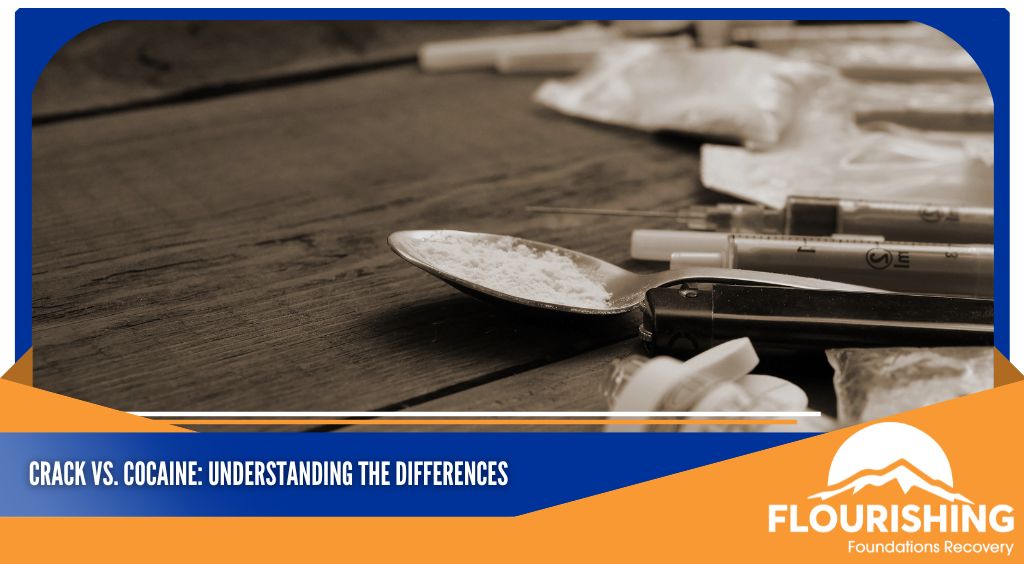Crack and cocaine get a lot of attention in the news and popular media. Using crack or cocaine can have disastrous effects on your safety, health, and general well-being. But what is the difference between crack and cocaine?
People may wonder about the differences and similarities between cocaine and crack. Some people may even use these terms to mean the same thing. Understanding the differences between these drugs and their risks can help you get the help you need to overcome cocaine and crack addiction.
This article will explore crack and cocaine, the differences between these substances, and how to find help to overcome substance abuse. Reach out to the specialists at Flourishing Foundations Recovery now to learn about our effective, holistic treatment programs or to schedule an intake into our rehab facility.
What is Cocaine?
Cocaine is a powerful, illegal stimulant drug derived from the South American coca plant. Users typically snort a powdered form of cocaine. Some dissolve and inject cocaine. Users may also heat and smoke a solid form of the drug, which is called “crack.”
The effects of cocaine include:
- Euphoria
- Mental alertness
- Increased energy
- Heightened senses
In addition to these desirable effects, cocaine users may also experience unwanted side effects, such as:
- Irritability
- Restlessness
- Tremors
- Muscle twitches
- Anxiety
- Paranoia
- Panic attacks
- Irregular heart rhythms
- Violent or erratic behaviors
Cocaine is highly addictive. Snorting cocaine produces effects that last a short time. This can result in users taking it frequently over a short period. Frequent substance use can lead to tolerance, which means that the body adjusts to the presence of a substance and requires more to experience the desired effects.
Over time, people who frequently use cocaine may become physically dependent on it. Cocaine abuse has both short and long-term effects on a person’s mental and physical health.
What is Crack Cocaine?
Crack cocaine is a solid form of cocaine. It looks like small, pale, or white crystals. Crack users heat the solid crack crystals and breathe in the smoke.
Smoking crack often leads to a quicker “high.” Some addiction experts believe that this has the potential to make crack more addictive than cocaine.
Crack cocaine’s popularity increased in the 1980s, causing legislators to create laws that allowed harsher penalties for people who used or sold it. However, crack use is still common in the United States. Research from 2021 showed that almost a million people aged 12 or older reported using crack in the previous year.
Crack vs. Cocaine: Understanding the Differences
Cocaine and crack are two forms of the same substance. Cocaine is the powdered form of the drug, and crack is the solid form. While they share a chemical composition, people mix cocaine with other substances, such as baking soda and other chemicals, to make crack. Mixing cocaine with these substances gets rid of the hydrochloride and results in a solid product.
There are some crucial differences between crack and cocaine. Here are some of the most significant differences between these substances.
Methods of use
Cocaine users typically snort powdered cocaine, inject it, or rub it onto their gums. The effects of cocaine can last for 30 minutes to an hour.
People who use crack heat the solid form and inhale the vapors. The effects start quickly but typically only last up to 20 minutes.
Effects
Cocaine and crack both cause increased energy, heightened senses, and euphoria. People who use these drugs may feel good for a short period, but the negative effects are often severe. Both drugs can also cause unwanted side effects and long-term damage, including heart attack, stroke, liver and kidney damage, and neurological problems. Both drugs are stimulants that can raise a person’s blood pressure and cause dangerously high body temperatures.
Crack and cocaine can have negative effects on your mental health. Users may experience new or worsening mental health problems.
Legal status
Cocaine is technically legal for use in a medical setting as an anesthetic. However, most medical professionals do not use it because of its risk of addiction and because there are more effective options available.
While crack is simply a solid form of cocaine, laws from the 1980s mandate harsher sentences for people who possess, use, or sell it.
Find Treatment for Crack or Cocaine Addiction
Using crack or cocaine can cause significant, long-term harm to your physical and mental health. Crack and cocaine addictions are complex conditions that require comprehensive addiction treatment.
A medically supported detox program can help you manage withdrawal symptoms so that you can have a safe, complete detoxification. After completing detox, you must participate in a comprehensive treatment program to address the underlying behavioral, physical, and emotional roots of your substance use.
Reach out to the team at Flourishing Foundations Recovery now to learn about our treatment programs or to schedule an intake assessment.
